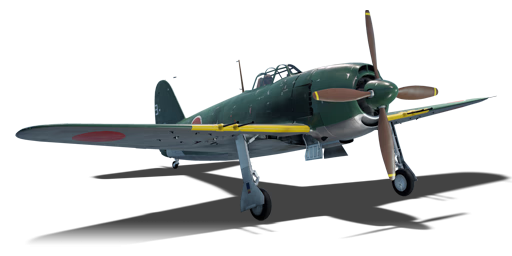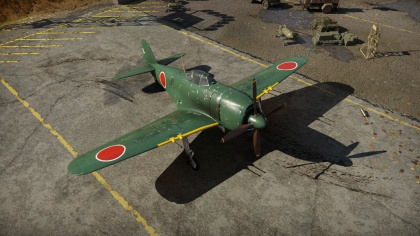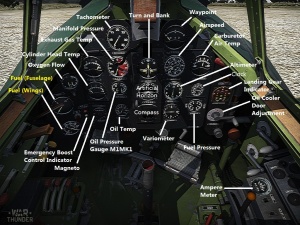Difference between revisions of "N1K2-J"
m (Moving Ingame Description to History) |
(Edits.) |
||
| Line 7: | Line 7: | ||
[[File:GarageImage_{{PAGENAME}}.jpg|420px|thumb|left]] | [[File:GarageImage_{{PAGENAME}}.jpg|420px|thumb|left]] | ||
{{break}} | {{break}} | ||
| − | The '''{{Specs|name}}''' is a Rank {{Specs|rank}} Japanese fighter {{Battle-rating | + | The '''{{Specs|name}}''' is a Rank {{Specs|rank}} Japanese fighter {{Battle-rating}}. It was in the game since the start of the Open Beta Test prior to Update 1.29. |
| − | The N1K2-J is a versatile plane that has its great acceleration and rate of climb as | + | The N1K2-J is a versatile plane that has its great acceleration and rate of climb as the main advantage. It lacks the impressive low-speed manoeuvrability of its preceding plane in the Japanese research tree, but it can still turn against most of its fighter opposition and win the engagement. The N1K2-J's battle rating presents the potential challenge of flying against fighter jets, against which N1K pilots will have to use their high sustained rate of climb, not to be left low and vulnerable against faster enemies, as well as to use their turning ability far superior to that of the average jet. |
The N1K2-J can carry one of the following additional load outs, under the wings. The rockets were designed for anti-air usage versus bombers, however they are quite inaccurate and only one salvo can be fired in RB/SB. Make sure to select a detonation range before spawning in. Feel free to experiment, 300-700 m are common values. The bigger 250 kg bombs are useful in long enduring games, were few players are left and victory is determined by the last ground units. Ignore the 60 kg, your cannons will do more damage in the long run. | The N1K2-J can carry one of the following additional load outs, under the wings. The rockets were designed for anti-air usage versus bombers, however they are quite inaccurate and only one salvo can be fired in RB/SB. Make sure to select a detonation range before spawning in. Feel free to experiment, 300-700 m are common values. The bigger 250 kg bombs are useful in long enduring games, were few players are left and victory is determined by the last ground units. Ignore the 60 kg, your cannons will do more damage in the long run. | ||
| Line 28: | Line 28: | ||
! rowspan="2" |Take-off run<br>(meters) | ! rowspan="2" |Take-off run<br>(meters) | ||
|- | |- | ||
| − | ! | + | ! AB |
! RB | ! RB | ||
! AB | ! AB | ||
Revision as of 14:54, 19 March 2019
Contents
| This page is about the aircraft N1K2-J. For other uses, see N1K (Disambiguation) |
Description
The N1K2-J Shiden-Kai is a Rank IV Japanese fighter
with a battle rating of 5.7 (AB) and 6.0 (RB/SB). It was in the game since the start of the Open Beta Test prior to Update 1.29.
The N1K2-J is a versatile plane that has its great acceleration and rate of climb as the main advantage. It lacks the impressive low-speed manoeuvrability of its preceding plane in the Japanese research tree, but it can still turn against most of its fighter opposition and win the engagement. The N1K2-J's battle rating presents the potential challenge of flying against fighter jets, against which N1K pilots will have to use their high sustained rate of climb, not to be left low and vulnerable against faster enemies, as well as to use their turning ability far superior to that of the average jet.
The N1K2-J can carry one of the following additional load outs, under the wings. The rockets were designed for anti-air usage versus bombers, however they are quite inaccurate and only one salvo can be fired in RB/SB. Make sure to select a detonation range before spawning in. Feel free to experiment, 300-700 m are common values. The bigger 250 kg bombs are useful in long enduring games, were few players are left and victory is determined by the last ground units. Ignore the 60 kg, your cannons will do more damage in the long run.
General info
Flight Performance
| Characteristics | |||||||
|---|---|---|---|---|---|---|---|
| Stock | |||||||
| Max Speed (km/h at 5,300 m) |
Max altitude (meters) |
Turn time (seconds) |
Rate of climb (meters/second) |
Take-off run (meters) | |||
| AB | RB | AB | RB | AB | RB | ||
| 609 | 594 | 11000 | 19.4 | 20.5 | 11.7 | 14.2 | 300 |
| Upgraded | |||||||
| Max Speed (km/h at 5,300 m) |
Max altitude (meters) | Turn time (seconds) | Rate of climb (meters/second) |
Take-off run (meters) | |||
| AB | RB | AB | RB | AB | RB | ||
| ? | ? | 11000 | ??.? | ??.? | ??.? | ??.? | 300 |
Details
| Features | ||||
|---|---|---|---|---|
| Combat flap | Take-off flap | Landing flap | Air brakes | Arrestor gear |
| ✓ | ✓ | ✓ | X | X |
| Limits | ||||
|---|---|---|---|---|
| Wing-break speed (km/h) |
Gear limit (km/h) |
Combat flap (km/h) |
Max Static G | |
| + | - | |||
| 0 | 450 | 520 | ~17 | ~14 |
| Optimal velocities | |||
|---|---|---|---|
| Ailerons (km/h) |
Rudder (km/h) |
Elevators (km/h) |
Radiator (km/h) |
| < 420 | < 460 | < 460 | > 240 |
| Compressor (RB/SB) | ||
|---|---|---|
| Setting 1 | ||
| Optimal altitude | 100% Engine power | WEP Engine power |
| 2,000 m | 1,875 hp | 2,100 hp |
| Setting 2 | ||
| Optimal altitude | 100% Engine power | WEP Engine power |
| 5,300 m | 1,675 hp | 1,876 hp |
Survivability and armour
- 70 mm Bulletproof glass - Armored windscreen
- 12 mm Steel plate in pilot's seat
Armaments
Offensive armament
The N1K2-J is armed with:
- 4 x 20 mm Type 99 Model 2 cannons, wing-mounted (200 + 250 rpg each wing = 900 total)
Suspended armament
The N1K2-J can be outfitted with the following ordinance:
- Without load
- 2 x 60 kg Navy Type 97 Number 6 ground bombs (120 kg total)
- 2 x 250 kg type 98 bombs (500 kg total)
- 4 x 250 kg type 98 bombs (1,000 kg total)
- 2 x 10 kg Type 3 No.1 Mod.28 Mk.1 rockets
- 2 x 15 kg Type 5 No.3 Mod.9 rockets
- 2 x 66 kg Type 3 No.6 Mod.27 Mk.1 rockets
- 2 x 84 kg Type 5 No.6 Mod.9 rockets
Usage in the battles
Manual Engine Control
| MEC elements | ||||||
|---|---|---|---|---|---|---|
| Mixer | Pitch | Radiator | Supercharger | Turbocharger | ||
| Oil | Water | Type | ||||
| Controllable | Not controllable | Not controllable | Not controllable | Separate | Not ontrollable | Not controllable |
Modules
| Tier | Flight performance | Survivability | Weaponry | |||
|---|---|---|---|---|---|---|
| I | Fuselage Repair | Radiator | 7 in (mod20) | |||
| II | Compressor | Airframe | Type 3 No.1 Mod.28 Mk.1 Rockets | Type 5 No.1 Mod.9 Mk.1 Rockets | ||
| III | Wings Repair | Engine | Offensive 20 mm | 12 in (mod30) | Type 3 No.6 Mod.27 Mk.1 rockets | |
| IV | Engine Injection | Cover | New 20 mm Cannons | Type 5 No.6 Mod.9 Rockets | ||
- Top speed and acceleration is an issue with stock aircraft. Compressor and New Engine greatly help. Having access to Offensive 20 mm belts is helpful for gaining options of ammunition types.
Pros and cons
Pros:
- Good maneuverability in medium speeds (above 400 kph)
- Great energy retention
- Combat flaps are efficient while in dogfights
- Decent rate of climb
- Good diving capabilities (considering its a Japanese plane)
- Absurd amounts of ammo for the 20 mm (225 rpg with an 900 rounds in total)
Cons:
- Mediocre roll rate
- Can be outmaneuvered easily by the fighters at its tier if not used correctly
- Easy to catch on fire
- Often faces jets
History
Ingame Description
Kawanishi Shiden-Kai Model 21, Kawanishi N1K2-J (code name ""George"") Marine Interceptor-Fighter.
A single-seat, all-metal monoplane fighter with a closed canopy. The ""Shiden"" holds a unique place in the history of airplane construction. This land-based interceptor was based on the N1K1, which had been designed to support amphibious operations.
The first prototype N1K1 ""Kyofu"" (""Mighty Wind"") was flown on May 6, 1942, and mass production began in May of 1943. However, when the first seaplanes started to arrive on the front, the situation in the Pacific theater had changed so that this type of plane was simply no longer needed. Therefore, a land version project of the fighter was developed as a private initiative, based on the Kyofu. Originally it was planned that the only distinction between the two planes was that the Shiden-Kai would have retractable landing gear instead of floats, but it was quickly decided that the engine should be replaced with a more powerful alternative. A four-bladed propeller with a diameter of 3.3 meters was selected for the plane. Such a large propeller size, along with the mid-wing aerodynamic design, forced the plane to be fitted with elongated, telescoping landing gear struts which folded during retraction.
The land-based version made its first flight on December 12, 1942. The prototype's private designation was the X1, and in mass production its designation became N1K1-J ""Shiden"" (""Purple Lightning""). Production began in August of 1943.
The new fighter proved to be an excellent interceptor. However, its operation was complicated by the frequent failure of its engine, the Homare 21, the complex design of its chassis, and its ineffective brakes. Consequently, the number of the N1K1-J's non-combat losses was very high. The next model of the Shiden was designed to eliminate these shortcomings.
The aircraft's redesign began simultaneously with the N1K1-J's military trials. The N1K2-J's first flight was made on December 31, 1943. The production model was designated the Shiden-Kai (""Purple Lightning Improved"") Model 21 Marine Fighter-Interceptor.
The new model, like its predecessor, featured a 14-cylinder air-cooled radial engine, the Nakajima Homare 21 NK9H, with a takeoff power of 1820 hp. It also retained the basic wing construction and armament of the N1K1-J. However, the Shiden-Kai was really a new plane. During the planning phase, special attention was given to ensuring ease of production and, at least to some extent, the use of readily available materials. The Shiden-Kai, unlike its predecessor, had a low-wing design which allowed the use of conventional landing gear. The new design was finally rid of the N1K1-J's main operational problems.
The shape of the fuselage was completely changed and somewhat lengthened, and the vertical tail fin was completely redesigned. The empty weight of the aircraft was decreased by 240 kilograms.
The N1K2-J was armed with 4 Type 99 Model 2 20mm wing-mounted cannons. The inner pair held 200 rounds of ammunition each and the outer held 250 each (900 rounds total).
On the two pylons suspended underneath its wings, the aircraft could carry two 250-kg type 98 or two 60-kg type 97 bombs. Or, it could carry unguided 60-kg No.27 rockets. In addition, an extra 400-liter fuel tank could be installed under the fuselage.
Because its center of gravity was towards the plane's rear, the N1K2-J was somewhat difficult to control, and was usually flown by experienced pilots (especially former Zero pilots) after they underwent retraining.
Media
An excellent addition to the article will be video guides, as well as screenshots from the game and photos.
Read also
Links to the articles on the War Thunder Wiki that you think will be useful for the reader, for example,
- reference to the series of the aircraft;
- links to approximate analogues of other nations and research trees.
Sources
Paste links to sources and external resources, such as:
- topic on the official game forum;
- page on aircraft encyclopedia;
- other literature.
| Japan fighters | |
|---|---|
| Navy | |
| Carrier-based fighter | |
| A5M | A5M4 · Hagiri's A5M4 |
| A6M | A6M2 mod. 11 · A6M2 · A6M3 · A6M3 mod. 22 · A6M3 mod. 22Ko · A6M5 · A6M5 Ko · A6M5 otsu · A6M5 Hei · A6M6c |
| A7He | A7He1* |
| A7M | A7M1 (NK9H) · A7M2 |
| Land-based Fighter | |
| J2M | J2M2 · J2M3 · J2M4 Kai · J2M5 · J2M5 (30 mm) |
| J6K | J6K1 |
| J7W | J7W1 |
| N1K-J | N1K1-Ja · N1K2-J · N1K2-Ja |
| Fighter seaplane | |
| N1K | N1K1 |
| A6M-N | A6M2-N |
| Army | |
| Ki-10 | Ki-10-I · Ki-10-I C · Ki-10-II · Ki-10-II C |
| Ki-27 | Ki-27 otsu · Ki-27 otsu Tachiarai |
| Ki-43 | Ki-43-I · Ki-43-II · Ki-43-III otsu |
| Ki-44 | Ki-44-I · Ki-44-I 34 · Ki-44-II otsu · Ki-44-II hei |
| Ki-61 | Ki-61-I ko · Ki-61-I otsu · Ki-61-I hei · Tada's Ki-61-I hei · Ki-61-I tei · Ki-61-II Otsu Kai |
| Ki-84 | Ki-84 ko · Ki-84 otsu · Ki-84 hei |
| Ki-87 | Ki-87 |
| Ki-94 | Ki-94-II |
| Ki-100 | Ki-100 · Ki-100-II |
| Other countries | ▅F4U-1A · ▅P-51C-11-NT · ▅Bf 109 E-7 · ▅Fw 190 A-5 |
| *Imported designation of the He 112 (A6M was in development - A7M would take A7 designation after the cancelation of the A7He) | |






